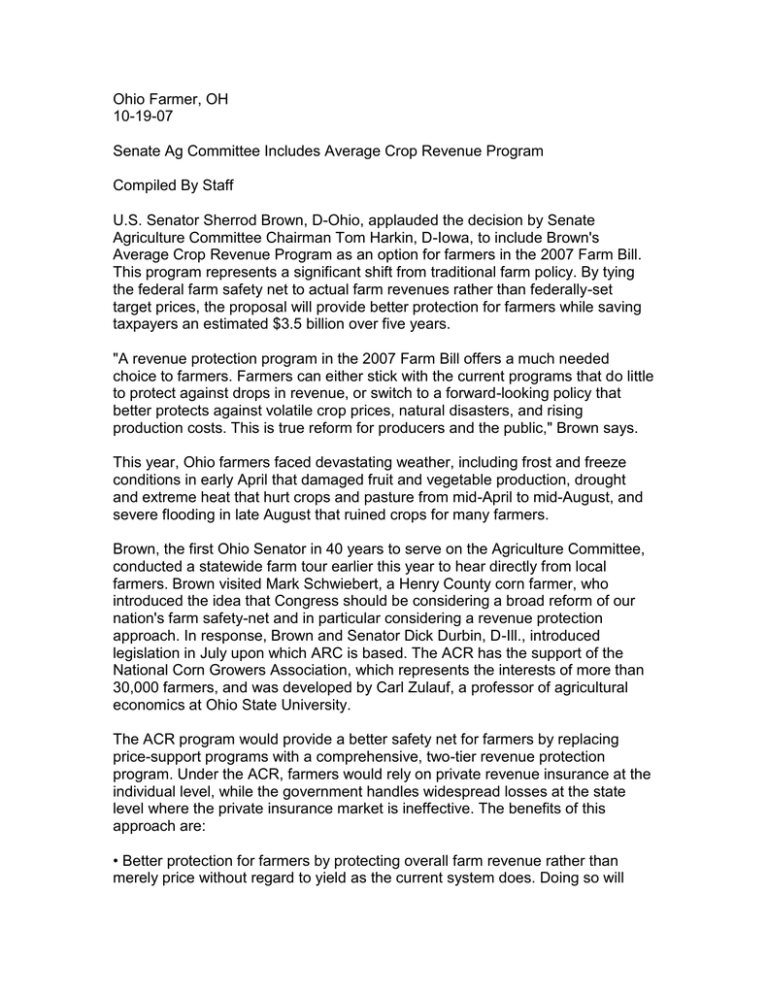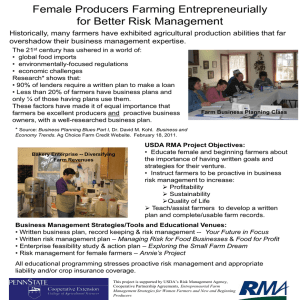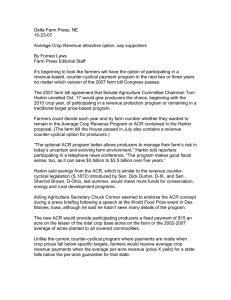Ohio Farmer, OH 10-19-07 Senate Ag Committee Includes Average Crop Revenue Program
advertisement

Ohio Farmer, OH 10-19-07 Senate Ag Committee Includes Average Crop Revenue Program Compiled By Staff U.S. Senator Sherrod Brown, D-Ohio, applauded the decision by Senate Agriculture Committee Chairman Tom Harkin, D-Iowa, to include Brown's Average Crop Revenue Program as an option for farmers in the 2007 Farm Bill. This program represents a significant shift from traditional farm policy. By tying the federal farm safety net to actual farm revenues rather than federally-set target prices, the proposal will provide better protection for farmers while saving taxpayers an estimated $3.5 billion over five years. "A revenue protection program in the 2007 Farm Bill offers a much needed choice to farmers. Farmers can either stick with the current programs that do little to protect against drops in revenue, or switch to a forward-looking policy that better protects against volatile crop prices, natural disasters, and rising production costs. This is true reform for producers and the public," Brown says. This year, Ohio farmers faced devastating weather, including frost and freeze conditions in early April that damaged fruit and vegetable production, drought and extreme heat that hurt crops and pasture from mid-April to mid-August, and severe flooding in late August that ruined crops for many farmers. Brown, the first Ohio Senator in 40 years to serve on the Agriculture Committee, conducted a statewide farm tour earlier this year to hear directly from local farmers. Brown visited Mark Schwiebert, a Henry County corn farmer, who introduced the idea that Congress should be considering a broad reform of our nation's farm safety-net and in particular considering a revenue protection approach. In response, Brown and Senator Dick Durbin, D-Ill., introduced legislation in July upon which ARC is based. The ACR has the support of the National Corn Growers Association, which represents the interests of more than 30,000 farmers, and was developed by Carl Zulauf, a professor of agricultural economics at Ohio State University. The ACR program would provide a better safety net for farmers by replacing price-support programs with a comprehensive, two-tier revenue protection program. Under the ACR, farmers would rely on private revenue insurance at the individual level, while the government handles widespread losses at the state level where the private insurance market is ineffective. The benefits of this approach are: • Better protection for farmers by protecting overall farm revenue rather than merely price without regard to yield as the current system does. Doing so will provide better protection at a lower price. Iowa State University modeling estimates that the cost will be about three quarters of today's insurance while providing farmers with revenue protection of 90%. • Less production distortions by using a revenue target that adjusts with the market rather than federally-set target prices and loan rates. The current program can encourage farmers to "plant for the program" and not for market demand. The ACR program reduces the incentive to overproduce on marginal land and helps reduce trade distortions. All commodities are treated equally based on market risk. • Private crop insurance works better by integrating private revenue insurance with federal revenue protection into a comprehensive program – making private revenue insurance more cost effective and allowing higher coverage levels at a lower cost for farmers. • Saves Money due to efficiencies by integrating crop insurance and commodity support programs, and eliminating excessive and duplicative payments. No longer will payments be made when prices momentarily fall, but a farmer's overall revenue is up.







